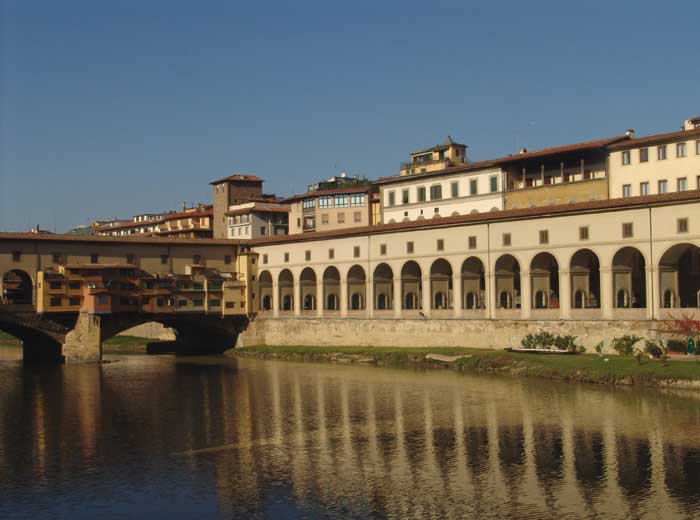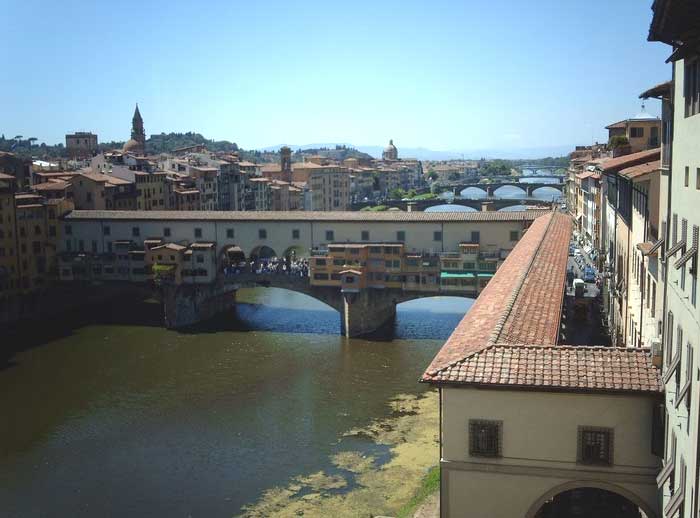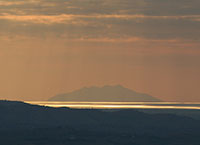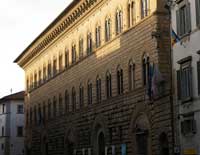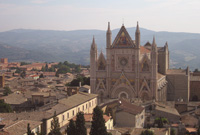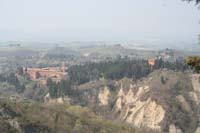| |
|
The Vasari Corridor or Corridoio Vasariano is an elevated enclosed passageway in Florence, central Italy, which connects the Palazzo Vecchio with the Palazzo Pitti. Beginning on the south side of the Palazzo Vecchio, it then joins the Uffizi Gallery and leaves on its south side, crossing the Lungarno dei Archibusieri and then following the north bank of the River Arno until it crosses the Ponte Vecchio. At the time of construction the Torre dei Mannelli had to be built around using brackets because the owners of the tower refused to alter it. The corridor covers up part of the façade of the chiesa di Santa Felicità. The corridor then snakes its way over rows of houses in the Oltrarno district, becoming narrower, to finally join the Palazzo Pitti. Most of it is closed to visitors.
Apart from the fact that the visitor can enjoy some magnificent and little-known views over the city from its round windows, the passageway contains over 1000 paintings, all dating from the 17th and 18th centuries, as well as the important collection of Self-portraits by some of the most famous masters of painting of the 16th to the 20th century.This collection, unique in the world, was created by Cardinal Leopoldo de' Medici in the mid 17th century, a golden century for collections, and receives regular additions to this day. It displays self-portraits by Andrea del Sarto, Beccafumi, Bernini, Annibale Carracci, Guido Reni, Salvator Rosa, Rubens, Canova, Hayez, Corot, Ingres, Delacroix, Ensor and many others.
|
|
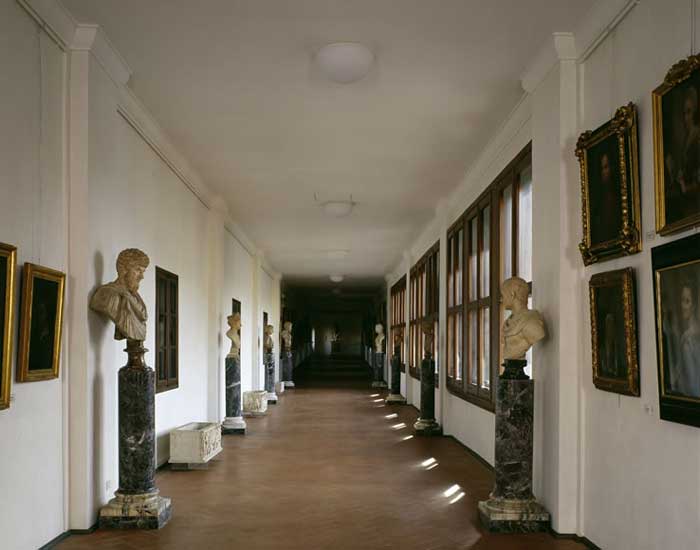 |
In its Uffizi section the Vasari Corridor is used to exhibit the museum's famous collection of self-portraits
|
The paintings in the Corridor are arranged in three major groups.
The first collection, which starts at the doorway from the Uffizi Gallery and ends as the Corridor turns on to the Ponte Vecchio, is a group of 17th and 18th century paintings by Italian and other European artists. Acquired by the Medici clan, Cardinal Leopoldo de’Medici at his death left a collection of 730 paintings, 318 sculptures, 1,245 drawings, 589 small portraits, and thousands of medals and other objet d’arte. A small portion of his collection is displayed in the Corridor, including a number of paintings from the school of Caravaggio. Notable among the first collection are pieces by Guido Reni, Gerrit van Honthorst, Empoli, and Guercino.
Next, as the Corridor starts across the Ponte Vecchio, there is the world’s largest collection of self-portraits, arranged chronologically, of Italian and other European artists. Cardinal Leopoldo, inspired to start the series, collected over 80 portraits in the 17th century. The set was then augmented by earlier pieces obtained by other members of the Medici family. Still more were added throughout the 18th, 19th, and 20th centuries by artist donation and acquisition by the Uffizi.
Only a portion of the total collection of self-portraits is hung on the Corridor walls at any one time. Those now on display include Giorgio Vasari, Titian, Correggio, Rubens, Rembrandt, Van Dyck, Velasquez, Sir Joshua Reynolds, Antonio Canova, Delacroix, John Singer Sargent, and Carlo Levi. The last displayed, but not the last to reach the Gallery, is a self-portrait donated by Marc Chagall in 1976. A fake Leonardo da Vinci is also displayed – it was part of the Medici collection, but was found by x-ray to be painted over a 17th century Magdalene.
|
History and overview
|
The Vasari Corridor was built in 5 months by order of Grand Duke Cosimo I de' Medici in 1564, to the design of Giorgio Vasari. It was commissioned in connection with the marriage of Cosimo's son, Francesco, with Johanna of Austria. The idea of an enclosed passageway was motivated by the Grand Duke's desire to move freely between his residence and the government palace, when, like most monarchs of the period, he felt insecure in public, in his case especially because he had replaced the Republic of Florence. The meat market of Ponte Vecchio was moved to avoid its smell reaching into the passage, its place being taken by the goldsmith shops that still occupy the bridge. At the latter extremity, the corridor was forced to pass around the Mannelli's Tower, after the staunch opposition of that family to its destruction.
In the middle of Ponte Vecchio the corridor is characterized by a series of panoramic windows facing the Arno, in the direction of the Ponte Santa Trinita. These replaced the smaller windows of the original construction in 1939, by order of Benito Mussolini.
After the Ponte Vecchio the Corridor passes over the loggiato of the church of Santa Felicita; at that point it had a balcony, protected by a thick railing, looking into the interior of the church, in order to allow the Grand Duke's family to follow services without mixing with the populace.
|
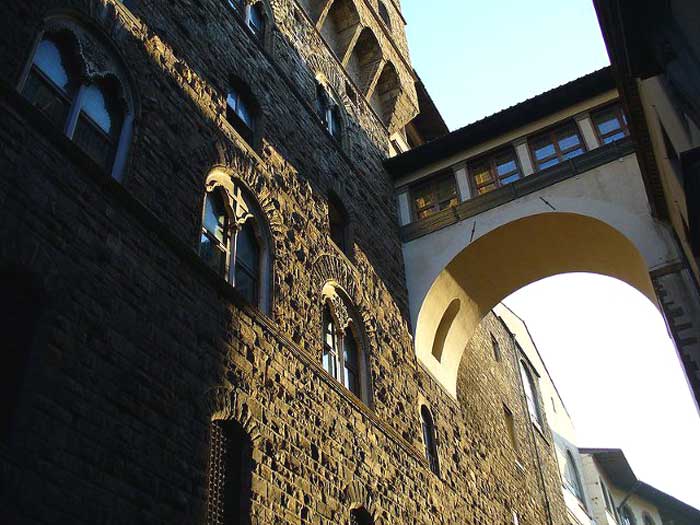 |
Vasari corridor from Palazzo Vecchio to Uffizi |
|
|
| |
|
Giorgio Vasari | Lives of the Most Eminent Painters Sculptors and Architects
Art in Tuscany | Art in Tuscany | Giorgio Vasari | Lives of the Most Excellent Painters, Sculptors, and Architects
Volume I | Cimabue to Agnolo Gaddi
Volume II | Berna to Michelozzo Michelozzi
Volume III | Filarete And Simone To Mantegna
Volume IV | Filippino Lippi To Domenico Puligo
Volume V | Andrea Da Fiesole to Lorenzo Lotto
Volume VI | Fra Giocondo To Niccolò Soggi
Volume VII | Tribolo to Il Sodoma
Volume VIII | Bastiano to Taddeo Zucchero
Volume IX | Michelagnolo To The Flemings

[1] Giorgio Vasari was born in 1511 in Arezzo as the son of a potter. After initial artistic instruction in his home town, Cardinal Silvio Passerini, the private tutor of the Medici family, arranged for him to come to Florence at the age of thirteen years, where he attended lessons together with the Medici sons, Alessandro and Ippolito. In addition to his humanistic education, he received education in art, which he then continued in the workshops of the painter Andrea del Sarto and the sculptor Baccio Bandinelli. He spent time in Arezzo, Pisa and Bologna before entering the service of the Medici family in 1532, his first trip to Rome followed in the same year; while there, he studied the art of antiquity as well as the works of contemporary artists. In particular, Michelangelo became the object of Vasari’s lifelong admiration. In the years following the violent death of his patron, Duke Alessandro de' Medici, in 1537, Vasari worked mainly outside of Florence. It was only in 1555 that he returned to the city on the River Arno, where Duke Cosimo I de’ Medici placed him in charge of the celebration of the Medici Family in the arts, such as the reconstruction and painting of the Palazzo Vecchio or the construction of the Uffizi. With these commissions and numerous others, Vasari quickly became one of the leaders of the Florentine art scene. By the time he died in Florence in 1574, he had made himself a name not only as a painter and architect, but also as a biographer and art theoretician. His “Lives of the Most Excellent Painters, Sculptors and Artists” was published in 1550, followed by a second extended edition in 1568. This work, which is still read today, made Vasari the father of modern art historiography.
|


Podere Santa Pia, a formal cloister in the Tuscan Maremma is situated on the outskirts of Castiglioncello Bandini, and dominates one of the most beautiful setting that nature can offer: the Tuscan countryside.
Tuscan Holiday houses | Podere Santa Pia
|
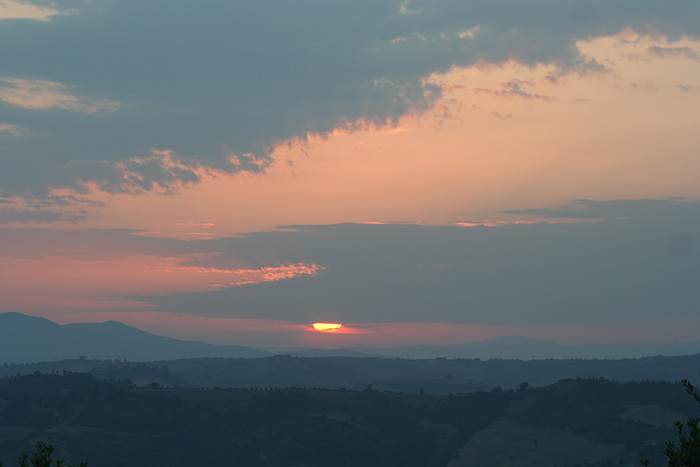 |
Podere Santa Pia, with a stunning view over the Maremma and Montecristo
|
| |
|
|
|
|
|
|
|
|
|
|
Podere Santa Pia |
|
Podere Santa Pia, garden |
|
Montecristo, view from Santa Pia
|
 |
|
|
|
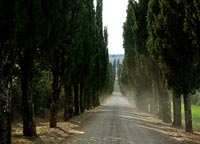 |
Sant'Antimo, between Santa Pia and Montalcino |
|
Palazzo Medici Riccardi, Florence |
|
Villa Arceno gardens |
| |
|
|
|
|
| |
|
|
|
|
The Powerful Families of Renaissance Italy
|
|
|
Many important cities in Renaissance Italy were ruled by hereditary noble families, elites in control of independent communes, republics, and former imperial fiefs that were at war with one another throughout of the 13th and 14th centuries. The borders of 1492 Italy were continually being shaped by some of these powerful ruling dynasties: the House of Este, the House of Medici, the House of Este, Dukes of Ferrara; the House of Sforza, Dukes of Milan; the House of Medici, Citizens of Florence; the House of Gonzaga, Marquises of Mantua; the House of Orsini; the House of Aragon (Naples); the House of Colonna; the House of Orsini, Lords of Bracciano; the House of Montefeltro, Dukes of Urbino; the House of Aragon, Kings of Naples; the House of Colonna, Lords of Palestrina; he House of Bentivoglio, Lords of Bologna, the House of Baglioni; Lords of Perugia, the House of Malatesta, Lords of Rimini and the House of Petrucci, Lords of Siena.
Two of the most famous, or infamous, Renaissance ruling families were the Medici family of Florence and the Borgia family of Rome. Perhaps less well-known and less powerful than the Medici, the Borgia family has an even more sinister reputation. They are remembered as much for their treachery as for their political accomplishments. The head of the family, Rodrigo Borgia (1431-1503), became Pope Alexander VI in 1492, an office he held until his death in 1503. Although Alexander supposedly died from malaria in 1503 at the age of seventy-two, rumors circulate even now that he met his end after mistakenly eating a piece of poisoned fruit intended for one of his guests.
By the end of the fifteenth and the beginning of the sixteenth century, both the Medici and the Borgia families were in trouble. When Lorenzo the Magnificent died in 1492, the Medici were toppled from power in Florence. Two years later, in 1494, the family was exiled and their property taken over by the city of Venice. Cesare Borgia outlived his father by four years, but steadily lost influence. Beset on all sides by his enemies, foremost among them the new pope Julius II, Cesare fled Rome only to be captured in Naples and imprisoned in Spain. He escaped but was killed in battle in 1507, ending the Borgia's dream of establishing a family dynasty on Italian soil. The Renaissance world of Lorenzo de' Medici and Cesare Borgia may have been beautiful and elegant but it proved also to be dangerous and impossible for any one man or family to master.
The Borgia family
At the time of the Borgia papacy, Italy was ruled by several types of government: territorial overlords called signore, marquises, dukes, and kings - as in the case of Naples (Venice was an oligarchial republic ruled by a military duke, called the Doge). Some of these princes were technically papal vassals - hereditary rulers who received the rights to own and inherit immovable property and revenue. They "owned" their lands under two major conditions: 1. They must send annual tribute to the granter, and 2. They must defend and protect the interest of the granter. The Kingdom of Italy, when it was a satellite of the Holy Roman Empire under Frederick I (Barbarossa), was ruled by imperial vassals who held northern Italian lands in fief for the Holy Roman Emperor. Gradual changes in the makeup of the Holy Roman Empire led to the deterioration of its control in much of northern and central Italy. Some of these lords and princes gradually asserted their authority and maintained their independence from the Empire. At the same time, they were alternately free, papal, and conquered realms until the Italian Wars (1494-1550s) and later Unification of Italy (1850s).
|
|
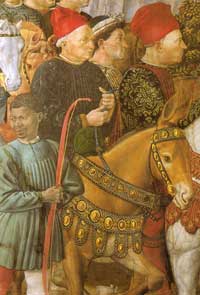
Giovanni di Cosimo de' Medici. Detail from the fresco by Benozzo Gozzoli, in the Cappella dei Magi, at Palazzo Medici Riccardi in Florence, Italy. |

Walking in Tuscany | Along the Vasari Corridor
|
|
|
In 2010, the Italian Cultural Ministry and the City of Florence, urged on by Mayor Renzi, created a special “Prince’s Itinerary”, Il Percorso del Principe, as a guided tour to introduce the public to the Vasari Corridor. Still relatively unknown, it is one of the most exceptional and, until recently, hidden treasures of Renaissance architecture and art.
Tour participants not only see a fabulous art collection, but also are shown a hidden route with unique views and unexpected secret glimpses of the classic Florentine cityscape while walking above the heads of tourists swarming the streets below.
The Percorso del Principe Tour begins in the courtyard of the Palazzo Vecchio. It always numbers less than 20 participants and lasts about two hours. The tour group meets in the courtyard of the Palazzo Vecchio, proceeds to the Hall of the Five Hundred, Il Salone dei Cinquecento, where an Italian-speaking guide presents a short history lesson regarding the Medici, the Palazzo Vecchio and the Vasari Corridor.
The itinerary includes parts of the Palazzo Vecchio Museum. Each group is escorted through a number of governmental chambers to Eleonora’s Green Room, La Camera Verde, in the former Medici family apartments on the second floor. From there the group crosses a short sky bridge, part of the original Corridor, over Via della Ninna, and enters the east wing of the Uffizi Gallery. Tour participants have a chance to examine only the east hallway of the Uffizi – the ticket does not allow for free re-entry into the Gallery that holds the largest collection of Italian medieval and Renaissance art in the world.
The main branch of the Vasari Corridor is entered via a doorway located at the beginning of the west corridor of the Uffizi. The passage drops down a long stairway flanked by paintings from the Medici collection and then traverses the top of the arcade on the north bank of the Arno, turns right over the shops on the Ponte Vecchio, and continues on through to the Boboli Gardens of the Palazzo Pitti. Visitors exit into the garden and can remain there for the rest of the day.
Small windows all along the Corridor provide excellent views of the river and the city. The best view is in the center of the Ponte Vecchio through two large sets of windows that look west down the Arno. These windows were not part on the original design, but were installed at the direction of Mussolini during World War II because Hitler and Mussolini wanted to look at the view while they held private meetings in the Corridor.
By some reports, Hitler’s fondness for the Corridor and the Ponte Vecchio spared both when the retreating Germans blew up all of the other bridges crossing the Arno as the Allies advanced on Florence in August 1944. The Corridor, however, was damaged by the dynamite set at the ends of the Ponte Vecchio to block passage over the Old Bridge.
Near the south bank of the river, the Corridor passes through the interior of the church of Santa Felicita. A Corridor window looks over the gray and white pietra serena interior of the chapel, and a door enters a high rear balcony, similar to an exclusive box at the opera, where the Medici family attended services in comfort and privacy.
|
|
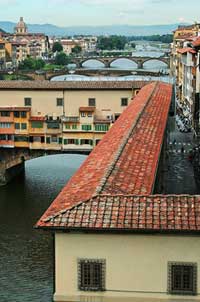
The West Corridor of the Gallery, heads towards the Arno and then, raised up by huge arches, follows the river as far as the Ponte Vecchio, which it crosses by passing on top of the shops. The meat market on the bridge was at this time trasferred elsewhere, so as not to offend the Grand Duke's sensitive nose with unpleasant smells on his walk, and replaced (from 1593) with the goldsmiths who continue to work there today. |
Past the church, the tour ends in the Boboli Gardens, next to the elaborate grotto designed by Bountalenti in the 1580s. At the end of the tour, participants may remain in the massive Giordino di Boboli to explore its many acres of walkways and gardens. Laid out for Eleonora di Toledo by Niccolo Tribolo in 1550, it is one of the finest examples of an Italianate landscape design.
The Corridor was restored and reopened to the public in 1973 but can only be visited by appointment or to groups (the entrance is between rooms 25 and 34). Tours are given only in Italian, but the viewing of the Palazzo Vecchio, Uffizi hallways and the Vasari Corridor is so interesting it’s worth the wait as explanations are made to Italian-speaking visitors.
Reservations should be made well in advance by calling +39 055.294.883 or through the Florence museum web site www.polomuseale.firenze.it. (The title of the tour is Percorso del Principe and the person taking your reservation will likely not understand if you say “Vasari Corridor”.)
If you are in Florence, tickets can be bought without reservation (if available) at the ticket office on the back of Orasanmichele on Via Calzaiouli or the ticket office at the Pitti Palace.
Address of the museum: Uffizi Gallery - Galleria degli Uffizi, Piazzale degli Uffizi 6 - Florence
See also Vasari corridor – a secret passage above Florence
Gardens in Tuscany | Boboli Garden
Art in Tuscany | Palazzo Pitti
|
|
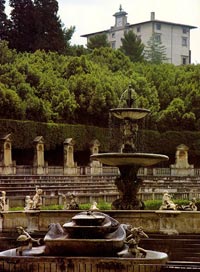
Boboli Garden
|
Walking in Tuscany | Florence | San Niccolo Neighbourhood in Oltrarno
|
|
|
This page uses material from the Wikipedia article Vasari Corridor published under the GNU Free Documentation License.
Wikimedia Commons has media related to Vasari Corridor.
|
|
|
|
|
 |
Orvieto, Duomo |
|
Monte Oliveto Maggiore abbey |
|
Florence, Duomo Santa Maria del Fiore |
| |
|
|
|
|
| Palazzi a Firenze / Palaces in Florence | Palazzo Acciaiuoli, Palazzo Adorni Braccesi, Palazzo degli Alessandri, Palazzo dell'Antella, Palazzo Antinori, Palazzo Arcivescovile, Palazzo dell'arte dei Beccai, Palazzo dell'Arte dei Giudici e Notai, Il Bargello, Palazzo Bartolini Salimbeni, Palazzo de' Benci, Palazzo di Bianca Cappello, Palazzo Buondelmonti, Palazzo dei Canonici, Palazzo Capponi Covoni, Palazzo Cocchi-Serristori, Palazzo dei Congressi, Palazzo Corsini, Palazzo Corsini al Prato, Villa Corsini a Castello, Palazzo Da Cintoia, Palazzo della Gherardesca, Palazzo Fenzi, Palazzo dei Frescobaldi, Palazzo Galileo, Palazzo Gondi, Palazzo Lenzi (French Consulate), Palazzo Giugni, Palazzo Guadagni, Palazzina della Livia, Palazzo Malenchini-Alberti, Palazzo Medici-Riccardi, Palazzo Mellini Fossi, Palazzo della Misericordia, Palazzo della Missione, Palazzo dei Mozzi, Palazzo Nasi, Palazzo Nonfinito, Palazzo Pandolfini, Palazzo Pazzi, Villa la Petraia, Palazzo Pitti, Palazzo Portinari Salviati, Palazzo delle Poste Centrali, Palazzo Pucci, Palazzo Ramirez de Montalvo, Palazzo Ricasoli, Palazzo Rucellai, Palazzo Sacrati (Guadagni-Strozzi di Mantova), Casino Salviati, Palazzo di San Clemente, Palazzetto Serragli, Palazzo Serristori, Palazzo Spini Feroni, Palazzo Strozzi, Palazzo Taddei, Palazzo Torrigiani Del Nero, Palazzo Uguccioni, Palazzo di Valfonda, Palazzo Vecchio, Villa il Ventaglio, Palazzo dei Visacci, Palazzo Vivarelli Colonna |
| |
|
|
![]()
![]()
![]()
![]()

